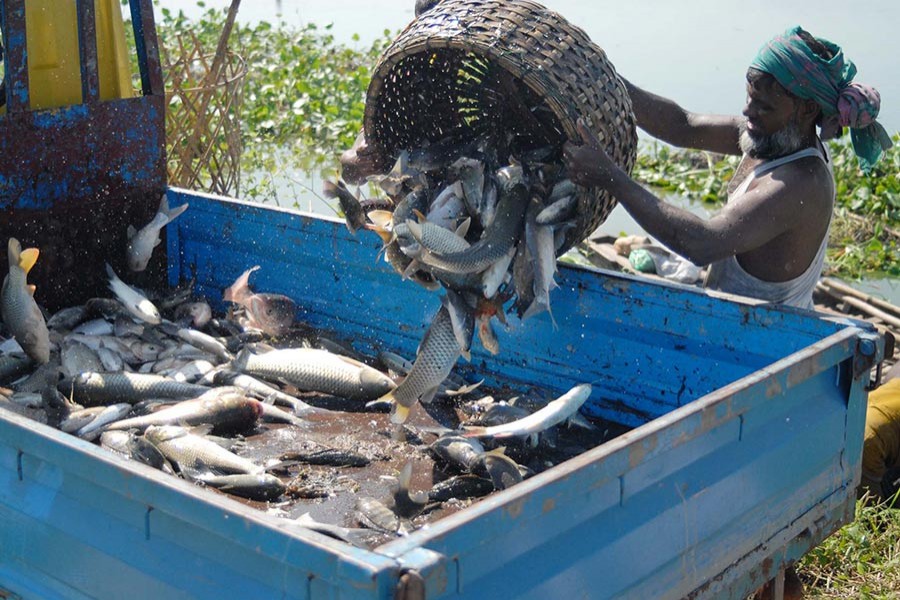Some 77.3 per cent of aquaculture farmers in the country cannot access credit from banks for a lack of collateral, a study has revealed.
As a result, many of them are compelled to borrow from various other sources, including NGOs, at a much higher rate of interest, often leading to severe hardship for them, the study said.
Major financial challenges facing the fish farmers include banks' reluctance to provide loans, long approval time, absence of grace period, high interest rate and weekly installment system of the lending organisations such as Non-Government Organisations (NGOs) and micro-finance institutions (MFIs).
The study also underscored the need for developing specialised credit products for fish farmers, particularly those running small and medium-sized farms.
The comprehensive study titled 'The aquaculture sector in Bangladesh with particular focus on existing policy support received by the sector and scope for improvements' was published recently.
Bangladesh Shrimp and Fish Foundation (BSFF) conducted the study to identify the ground-level production reality in the fisheries and aquaculture sector.
The study was carried out with support from the Department of Fisheries (DoF), Ministry of Commerce (MoC), and Swisscontact Bangladesh's market development project Katalyst.
According to the study, 44 per cent of the respondents received credit in various forms, while 56 per cent did not obtain any credit.
The loan amount received by large farms averages out at Tk 36,33,430, almost 15 times higher than the amount-Tk 2,35,000 -- received by a smaller farm.
According to the study, aquaculture farms spreading over 3.0 acres of water-body are large while farms having 0.51 to 3.0 acres are medium and those having less than 0.5 acres are small farms.
Only 19 per cent of small, 37 per cent of medium and 39 per cent of larger farms receive credit from the state-owned banks, it said.
Besides, as low as 5.0 per cent of small farms, 11 per cent of medium farms and 26 per cent of large farms receive credit from private banks, implying that smaller businesses' access to private banks is very limited.
The respondents identified inability to offer collateral as a major barrier to getting loans from the banks.
Majority owners of the smaller farms receive credit from relatives and friends; even few of them have to pay interest at varied rates.
Some 23 per cent of smaller farms take loans from NGOs and MFIs. While NGOs charge an interest rate of as high as 27 per cent, MFIs charge 20 per cent.
The average interest rate is 11 per cent for loans from government banks and 14 per cent for loans from private banks.
The study was conducted over a period of 12 weeks in early 2017. Representatives of 450 aquaculture farms in 19 upazilas of all divisions responded to the researchers' queries.
The study recommended that the sector requires more public support in order to fulfill the National Fisheries Policy and Shrimp Policy objectives, so that the country could improve the nutritional status, reduce poverty and sustain food security.
The sector's development will require bridging critical gaps of financial and manpower resources, it said.
"There is an imperative need to raise the profile of the sector in the national development planning, budget process and capacity building of the Ministry of Fisheries and Livestock and DoF," the study said.
The study also suggested exploring the possibility of developing an aquaculture insurance scheme.
"Lack of insurance coverage for aquaculture production was identified as one of the major constraints to access credit by over half of the survey respondents," the study mentioned.
Contacted, Director General of DoF Syed Arif Azad said the sustainability of the country's self-reliance in fish production largely depends on providing more financial support to the farmers, marginal ones in particular.
"Despite remarkable success, the fisheries sector is deprived of low-cost finance required to ensure its growth at the desired level," he said.
"Even sectors like livestock receive loans at the interest of 5.0 per cent and spices at 4.0 per cent only," he added.
Due to high production cost, the farmer's profit margin is very low, which may force them to switch over to other professions, he said.
The DoF formally requested the authorities concerned, including Bangladesh Bank (BB) and Ministry of Finance (MoF), on several occasions to provide loans with single-digit interest to the fish growers, he added.
In fiscal year 2016-17, the country produced 4.13 million tonnes of fish, more than 56 per cent of which came from aquaculture farms.


